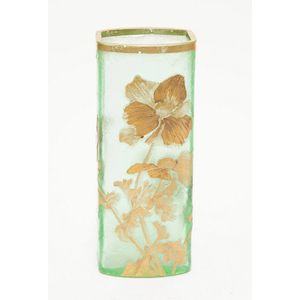Mont Joye Green Glass Spill Vase with Gilded Leaves
You must be a subscriber, and be logged in to view price and dealer details.
Subscribe Now to view actual auction price for this item
When you subscribe, you have the option of setting the currency in which to display prices to $Au, $US, $NZ or Stg.
- Gilding - Gilding is a method of ornamentation whereby a thin sheet of gold metal is applied to items made of wood, leather, ceramics, glass and silver for decorative purposes.
For furniture including mirrors, the sheet of gold is usually applied over a coating of gesso. Gesso is a mixture of plaster of Paris and gypsum mixed with water and then applied to the carved wooden frames of mirrors and picture frames as a base for applying the gold leaf. After numerous coats of gesso have been applied, allowed to dry and then sanded a coat of "bole", a usually red coloured mixture of clay and glue is brushed on and allowed to dry, after which the gold leaf is applied. Over time parts of the gilding will rub off so the base colour can be seen. In water gilding, this was generally a blue colour, while in oil gilding, the under layer was often yellow. In Victorian times, gilders frequently used red as a pigment beneath the gold leaf.
Metal was often gilded by a process known as fire gilding. Gold mixed with mercury was applied and heated, causing the mercury to evaporate, the long-term effect of which was to kill or disable the craftsman or woman from mercury poisoning. The pursuit of beauty has claimed many victims, not the least of which were the artists who made those pieces so highly sought after today. - Art Nouveau Period - The Art Nouveau period was a cultural movement that emerged in the late 19th century, and was characterized by its emphasis on natural forms, flowing lines, and a decorative, ornamental style. Art Nouveau was a reaction against the ornate and heavily stylized designs of the previous era, and sought to create a new, more organic aesthetic.
Art Nouveau was characterized by its use of sinuous, curving lines, as well as a focus on natural elements such as flowers, vines, and other organic shapes. Art Nouveau designers sought to create a total work of art, in which every element of a building or object was designed to be harmonious with the overall design.
Some of the most iconic examples of Art Nouveau design include the Paris Metro entrances designed by Hector Guimard, the works of the artist Alphonse Mucha, and the architecture of Victor Horta in Brussels.
The Art Nouveau period was at its peak between 1890 and 1910, but began to decline in popularity by the start of World War I. However, Art Nouveau remains an important influence on design and art to this day, and continues to be celebrated for its emphasis on natural forms and decorative style. - Spill Vase - Popular in Victorian times, a spill vase was a vessel for holding thin slips of wood or spills of paper with which to light a candle or pipe from a fire. For ease of access to the fire, they usually sat on the mantlepiece or had a hole in the back, so they could be hung from a wall. Their use declined with the with the evolution of heating through use of electricity and the use of safety matches in the late 19th century.
This item has been included into following indexes:
Visually similar items

Carved and gilt wood standing Buddha, 20th century, applied glass mosaics, on wooden stand, height 200 cm

A hardwood carving screen with ivory and bone inlaid, 20th century. 20.5 cm high

An ivory netsuke of a horse, Meiji period, 19th century, the recumbent sleeping horse, lightly engraved and inked; unsigned. Height 3.5 cm

Rare Chinese porcelain. Hat stand, with dated inscription to 1915. Decorated with newspaper cuttings. Apocryphal Qianlong mark. Provenance: Ex Geoffrey C Perkins collection. Illustrated 'Allen's Authentication of Latese Porcelain', Fig. 48. Height 28 cm
